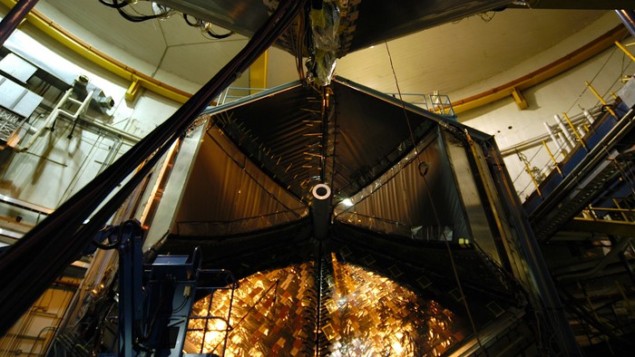
Extensive analysis of data gathered almost 20 years ago has led to a surprising discovery: that strange matter can be formed when a single photon is absorbed simultaneously by two quarks. The research was led by Lamiaa El Fassi at Mississippi State University and poses fundamental questions about the nature of the strong nuclear force.
Strange-matter particles called lambda baryons contain one each of an up, down, and strange quark. Their quark composition means that these particles are an especially appealing target for physicists studying the strong interaction – the fundamental force that binds quarks together.
Yet due to their fleeting lifetimes, lambda baryons cannot be observed directly. Instead, researchers can identify them by detecting their decay products. These are a pion, and either a proton or a neutron.
Exotic baryons
In 2004, experiments at the Continuous Electron Beam Accelerator Facility (CEBAF), part of Jefferson Lab in Virginia, aimed to gain a better understanding of these elusive particles. The accelerator produces a steady stream of energetic electrons, making it ideal for studying exotic baryons formed through a process called semi-inclusive deep-inelastic electron-nucleon scattering (SIDIS).
In this particular process, CEBAF’s electrons were scattered by protons and neutrons in targets made from deuterium, carbon, iron, and lead. “Because the proton or neutron is totally broken apart, there is little doubt that the electron interacts with the quark inside,” El Fassi explains.
Following this disintegration, the affected up or down quark – which interacts with a beam electron via a virtual photon – moves around briefly as a free particle, before binding together with other quarks it encounters to form a new hadron. In some exceptional cases, it may bind together with another up or down quark and a strange quark – forming a lambda baryon.
Decay products
In the CEBAF experiment, these particles could only be identified by a combination of their decay products and the scattered electrons. The challenges presented by such an indirect measurement have meant that conclusive results have been a long time coming. Yet after over a decade of thorough analysis, beginning when El Fassi was a postdoctoral researcher, she and her team have finally been able to observe lambda baryons in the collisions.
“These studies help build a story, analogous to a motion picture, of how the struck quark turns into hadrons,” El Fassi explains. “In a new paper [in Physical Review Letters], we report the first-ever observations of such a study for the lambda baryon in the forward and backward fragmentation regions.” These regions refer to the direction of motion of the detected proton or neutron following the lambda’s decay, relative to the incoming electron beam.
The team’s analysis unveiled an especially surprising outcome. Unlike when SIDIS produces lighter particles with longer lifetimes, CEBAF’s electrons did not seem to interact with single quarks in this case, but with a pair of quarks (called a diquark) – which goes on to bind with a strange quark.
Different mechanism
“This quark pairing suggests a different mechanism of production and interaction than the case of the single quark interaction,” Hafidi says.

Cosmic-ray detector might have spotted nuggets of dark matter
Indeed, the implications of this discovery could be particularly striking for quantum chromodynamics (QCD), which is the theoretical framework describing the strong nuclear force.
“There is an unknown ingredient that we don’t understand,” says team member William Brooks at Federico Santa María Technical University in Chile. “This is extremely surprising, since the existing theory can describe essentially all other observations, but not this one. That means there is something new to learn, and at the moment, we have no clue what it could be.”
In the future, the team hopes that upcoming improvements to CEBAF and its detectors could bring them a step closer to answering these fundamental questions. As El Fassi explains, “any new measurement that will give novel information toward understanding the dynamics of strong interactions is very important”.



